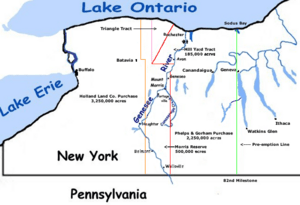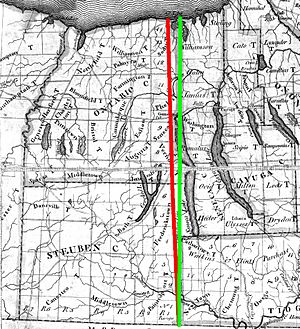Preemption Line facts for kids
The Preemption Line was an important boundary line in western New York. It separated land given to New York from land given to Massachusetts after the Treaty of Hartford (1786) in 1786. This line ran straight north from the Pennsylvania-New York border all the way to Lake Ontario.
Contents
Why Was This Line Created?
This special line was created because both New York and Massachusetts claimed the same land in what is now western New York. To solve this problem, they signed the Treaty of Hartford (1786) in 1786. This treaty decided that the land west of the Preemption Line belonged to New York. However, Massachusetts got the "preemptive right" to buy this land from the Native American tribes who lived there.
The word "preemption" means having the first chance to buy something. So, Massachusetts had the first chance to buy land from the Haudenosaunee (Iroquois) tribes. Also, it meant that individual people could not buy land directly from the tribes. They had to get permission from the state government first.
The Preemption Line was bordered on the east (New York's side) by:
- The towns of Galen and Junius near Seneca Lake.
- The Watkins and Flint Purchase area.
- A small strip of land near Seneca Lake bought by James Watson.
On the west (Massachusetts's side), it was bordered by the Phelps and Gorham Purchase.
Key Dates for the Preemption Line
Here is a timeline of important events related to the Preemption Line:
- 1628: King Charles I of England gave land to the Massachusetts Bay Colony. This land included what is now New York State.
- 1664: King Charles II of England gave land to his brother, the Duke of York. This land also included what is now New York State.
- 1783 (September 3): The Treaty of Paris (1783) ended the American Revolution.
- 1784: The Treaty of Fort Stanwix (1784) was signed. In this treaty, the Haudenosaunee (Iroquois) tribes gave up land west of New York State to the U.S.
- 1786 (December 16): The Treaty of Hartford (1786) settled the land claims between Massachusetts and New York. New York got its current shape. The land west of the Preemption Line was part of New York but was still owned by the Haudenosaunee (Iroquois) tribes. Massachusetts had the first right to buy it.
- 1788 (April 1): Massachusetts agreed to sell its right to buy the land to Oliver Phelps and Nathaniel Gorham.
- 1788 (July 8): Phelps and Gorham bought about 2.6 million acres from the Haudenosaunee (Iroquois) tribes.
- 1788 (July 25): Colonel Hugh Maxwell started surveying the first (incorrect) Preemption Line.
- 1792 (November): Benjamin Ellicott began surveying the second (correct) Preemption Line.
- 1796 (April 6): New York State officially accepted the second Preemption Line.
The Old and New Preemption Lines
Interestingly, there are actually two Preemption Lines: the Old one and the New one. The New line is a bit to the east of the Old one. The area between them is called the "Gore," which means a wedge-shaped piece of land.
This happened because soon after the first survey in 1788, people suspected it was wrong. So, a new survey was ordered in 1792. It showed that the first surveyors made mistakes. The first line started at the correct point but then curved about 2 degrees west. This made the "Gore" wider as it went north.
The first mistake actually gave more land to New York. New York had already sold land in the Gore, including the city of Geneva. The new survey was accepted because it was done very carefully by Benjamin Ellicott. He had just helped survey the District of Columbia (where Washington D.C. is).
You can see how big the error was in Geneva. The true (new) line goes through the middle of Seneca Lake. But the false (old) line is where Pre-emption Road is today, about two miles west of the city.
Where Are the Preemption Lines Today?
Both lines start at the same point: the 82nd milestone marker on the Pennsylvania–New York border. This marker is on Widger Hill Road near Millerton, PA. 42°00′04.58″N 76.0°57.0′57.52″W / 42.0012722°N 76.9659778°W
The Old Preemption Line Today
You won't find traces of the Old Preemption Line south of Schuyler County. This is probably because not many people lived there before the new survey was done.
In Schuyler County, it forms the western border of the town of Reading. Much of this section follows Pre-emption Road. It also forms a short part of the border between Schuyler and Yates Counties. Then it divides the Yates County towns of Barrington (west) and Starkey (east). A small part of a road through Milo Center is on this line.
In Ontario County, the Pre-emption Road also marks the line through the towns of Geneva and Phelps. This road sometimes moves a little off the exact line. Pre-emption Road continues a short way into Wayne County but then disappears.
The New Preemption Line Today
This line forms the border between Chemung (east) and Steuben (west) Counties. It also forms a small part of the border between Chemung (east) and Schuyler (west) Counties near Beaver Dams.
Then it forms the line between the towns of Orange (west) and Montour (east) in Schuyler County. Only a few roads follow this line here, like parts of Widger Hill Road and Locust Lane.
There is a sign where the line crosses NY 352 and the Keuka Outlet Trail. The line then goes through Seneca Lake from a point north of Dresden.
At the north end of Seneca Lake, it forms the border between Seneca (east) and Ontario (west) Counties. Here, it is marked by Pre-emption Road and West Town Line Road.
In Wayne County, it continues north as the line between the towns of Lyons and Sodus (west) and Galen, Rose, and Huron (east). Small parts of roads show its path. The line finally ends in Lake Ontario's Sodus Bay.




